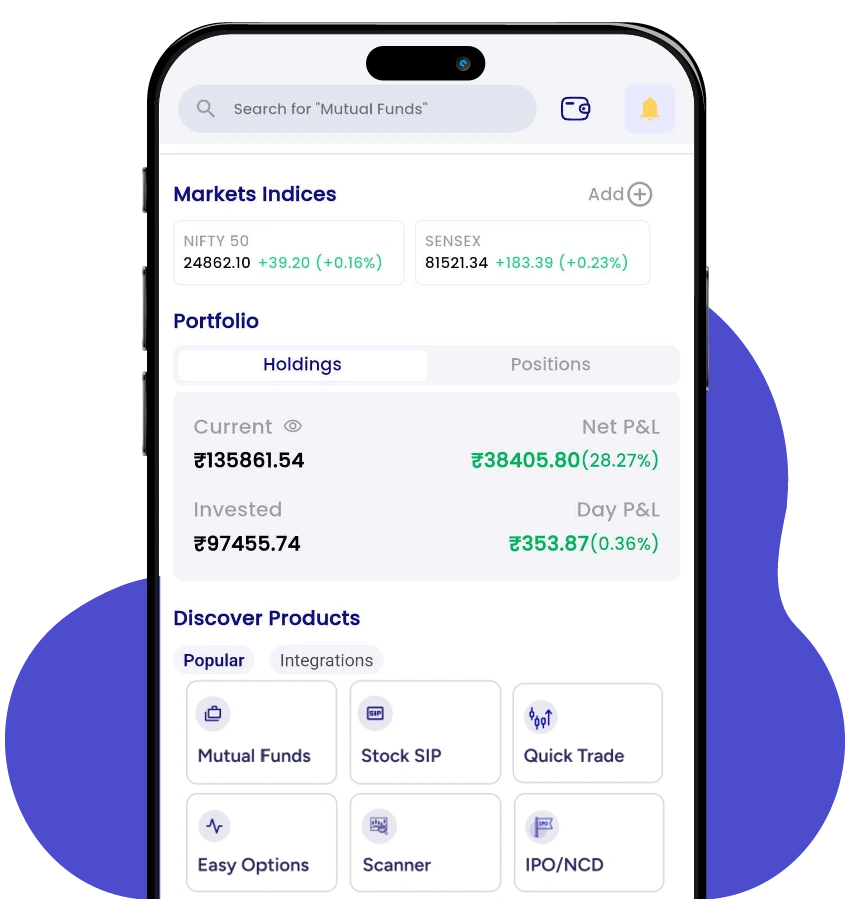Different Types Of Options
- 23rd July 2025
- 12:00 PM
- 12 min read
Since the launch of equity derivatives in 2000, derivative trading in India has grown exponentially. According to Axis Securities, equity derivatives now dominate the market, contributing 99.6% of trading volumes, amounting to a massive USD 4.3 trillion daily. Among these, options stand out by offering the right, but not the obligation, to buy or sell assets at a set price on a future date.
This blog dives into the different types of options every Indian investor should understand before stepping into the world of derivatives.
What are the Different Types of Options?
Options trading has different types based on numerous parameters. Primarily, there are two types of options: call options and put options. You can find different ways and strategies to diversify your portfolio and hedge against potential losses. Understanding these diverse types of options trading is crucial to tackling market complexities with more informed decisions.
What is a Call Option?
Imagine you think the price of company ABC will reach INR 120 per share in one month from a current price of INR 100 per share and a premium of INR 50 per share. You can purchase those shares at a strike price of INR 100 using a call option.
A call option is a type of options contract that gives you the right but not the obligation to purchase or sell an underlying asset at a predetermined price on a fixed date. Since you feel ABC’s share price will increase, a call option can offer you the benefit of buying the shares with INR 100.
This gives you the possibility to make a profit of INR 20 per share. A premium is a price that you pay for granting the right to buy the shares. Now, there can be two scenarios:
Scenario 1
If the price reaches INR 120 before the specified date after a month, you make a profit of INR 20 per share.
Scenario 2
If the stock price remains INR 100 or decreases, you lose the premium paid to buy the options contract.
What are the Types of Call Options?
There are two types of call options strategies you can use:
-
Long Call Option Strategy
You can use a long call option strategy to buy an underlying asset at a predetermined price, expecting it to rise. You have the right not to exercise the contract if the price remains stable or decreases.
-
Short Call Option Strategy
With a short call options strategy, you can sell an options contract by expecting the price of the asset to remain stable or decrease. If your prediction goes right, you can earn the premium paid by the buyer. However, you may incur a huge loss if the price rises and the buyer exercises the contract.
What is a Put Option?
As a seller of ABC shares, you can think that the price of company ABC shares will reach INR 80 per share in one month from the current price of INR 100 per share. You can buy a put option contract at INR 100 with a premium of INR 50 per share.
Now, a put option gives you the right but not an obligation to sell an underlying asset at a strike price before or on an expiry date. This type of options trading helps you to make a profit when you think the price of an asset will decrease from its current price.
Following the above example, you have two possible scenarios:
Scenario 1
If the price reaches INR 80, you can earn a profit of INR 20 per share by selling them at INR 100.
Scenario 2
If the stock price rises from INR 100, you lose the premium paid to sell the options contract and face a huge loss.
What are the Types of Put Options?
Put options are also categorised into two strategies:
-
Long Put Option Strategy
You can use a long put option strategy to sell an underlying asset at a predetermined price, expecting the price to drop. You have the right not to exercise the contract if the price remains stable or increases.
-
Short Put Option Strategy
You may use a short put options strategy to buy an option by expecting an asset’s price to increase. You can earn a premium paid by the seller of the asset if their prediction goes wrong. However, you may incur a huge loss if the price drops, as the spot price will remain below the strike price.
Understanding the Payoffs for Options
The payoffs for call and put options vary due to the different objectives of buying and selling these contracts. Here are the payoff scenarios in an options contract from both the buyer’s and seller’s perspectives:
-
Call Option for Buyer’s Perspective
A call option buyer anticipates that a price will go higher, and he or she pays a premium to a seller for the right to buy the asset. Now, two possible scenarios for payoffs are:
Scenario 1
The price of an underlying asset increases. The buyer can exercise the option and buy it at a lower strike price and sell it at a higher market price. In this case, the buyer has a high potential to earn profit since the asset price can continue to increase beyond the strike price.
Scenario 2
The price of an underlying asset decreases or falls below the strike price. In this scenario, the buyer does not exercise, and the buyer’s loss is limited to the premium paid for the options.
-
Call Option from the Seller’s Perspective
A seller takes a premium from the buyer and anticipates that the price will remain the same or decrease. Possible scenarios of payoffs are:
Scenario 1
The buyer does not exercise the option if an underlying asset’s price remains the same or goes below the strike price. The seller gets the premium as maximum profit.
Scenario 2
If the price goes higher than the strike price, the seller can face unlimited loss. They are obliged to sell the asset at a lower strike price while the current price is higher.
-
Put Option for Buyer’s Perspective
While purchasing a put option, a buyer gets the right to sell an underlying asset at a strike price by paying a premium. He or she anticipates that the asset’s market price will drop below the strike price. Possible payoff scenarios for the buyer are:
Scenario 1
If the asset’s spot price falls below the strike price, the buyer can exercise the option and sell it higher than the current market price. The buyer can gain unlimited profit if the asset price falls towards zero.
Scenario 2
If the asset price remains equal to the strike price or goes above, buyers may not exercise the option. However, loss of buyers is not limited to the premium paid.
-
Put Option for Seller’s Perspective
A seller of a call option receives a premium, which is their maximum possible gain. The seller expects the price to remain the same or go higher. Possible payoff scenarios of a seller are:
Scenario 1
If the asset price remains the same as the strike price or goes above, the contract remains unexercised. The seller can get a premium as his or her maximum profit.
Scenario 2
The seller will be obliged to buy the asset at a higher price if the price falls below the strike price.
However, you can download the PL Capital Group – Prabhudas Lilladher application if you are new to the derivatives market and want to trade futures and options.
What are the Different Types of Options Based on Underlying Security?
The flexibility of options trading allows traders to take advantage of the different forms of options and various market scenarios. Here are some of the common types of options based on underlying security:
-
Stock Options
Stock options have shares of a listed company as their underlying asset. These companies are listed on the exchanges like the National Stock Exchange (NSE) and the Bombay Stock Exchange (BSE).
-
Index Options
Index options contracts have a market index as their underlying asset. The Nifty 50 and Bank Nifty are the most actively traded index options in India. These options allow traders to hedge against the overall market movement.
-
Futures Options
The underlying asset in this type of option is the futures contract. Using this type of option allows you to hedge against your investments in futures contracts.
-
Currency Options
Currency options help you trade specific currency pairs like USD/INR and EUR/INR at a predetermined price and on a specific date.
-
Commodity Options
The underlying asset in a commodity option can be physical commodities or a commodity futures contract. For instance, the Multi Commodity Exchange offers you options on gold, silver, crude oil, and natural gas. You can manage the risks in the commodity market using this type of option.
What are the Different Types of Options Based on Expiration Cycle?
The expiration cycle is a crucial aspect of options contracts. It is the timeframe within which the contract holder exercises their right to exercise the option. Here are the different types of options based on expiration cycle:
-
Regular Options
Regular options are one of the most used options contracts that have a standard expiration cycle. In regular options, you can choose from at least four different expiration months according to your preference and investment strategy.
-
Weekly Options
Weekly options have the shortest expiration date among all other types of option contracts. These contracts have an expiration date of one week. You have to exercise these options within that week; otherwise, they become worthless.
-
Quarterly Options
Quarterly options, or quarterlies, allow investors to choose an expiry cycle between the nearest four quarters with a final quarter of the following year.
-
Long-Term Options
The expiry cycle of a long-term option lasts from one to three years before the expiry. If you have a long-term horizon, you can choose a long-term options contract. These options are more expensive than the other types of contracts due to their greater time value.
You can open a trading account with PL Capital, which charges zero AMC. PL’s research-backed advisory strategies can help you choose an expiration cycle that is better aligned with your investment goals.
What are the Applications of Options Contracts?
Options contracts offer you flexibility and help you hedge against potential losses. However, you can use options contracts for the following applications:
-
Investment Hedging
Options contracts can help you protect your investments against adverse price movements. For instance, you can buy a call option contract to buy shares for INR 100 after one month, even if the market price reaches INR 150. This approach ensures your safety, especially in volatile markets.
-
Bullish Speculation
Options contracts also become useful when you are expecting a rise in the price of an underlying asset. Following the above example, you can buy a security at a lower strike price while the current market price is higher.
-
Bearish Speculation
You can also use an options contract while anticipating a bearish trend in the market. You can use a put options contract to sell securities worth INR 100 after one month, even if the market price falls to INR 70.
-
Production Hedging
Businesses and manufacturing sectors can also use options contracts to remain safe from price fluctuations of raw materials or commodities. A manufacturing firm can use call options to determine the price of crucial raw materials to make stable production costs in a volatile market.
Final Thought
Before you start options trading, you must be aware of their different expiration cycle and which underlying security they hold. The payoff structures of call and put options are also crucial to understanding the buyer and seller perspectives.
Download the PL Capital application to open a trading account with zero AMC. PL offers you the platform to trade in futures and options. It also provides appropriate recommendations that help you choose the right type of options contract.
Frequently Asked Questions
1. How can I know what options to buy?
It completely depends on your financial goals and risk tolerance, which options you should buy. Based on these factors, you can choose between straddle, bear put spread, bear call spread, bull call spread, and bull put spread to maximise your returns.
2. How do call and put options function?
Both call options and put options function differently. A call option gives you the right to buy, while a put option gives the buyer the right to sell an underlying security at a predetermined price within a specific timeframe.
3. Can option contracts be considered assets?
Yes, options contracts are assets since they derive value from an underlying asset and can be bought or sold in the market.





